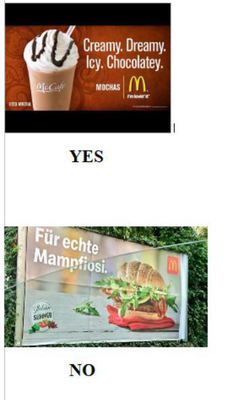Speaking slogans - workshop in Poland
- Let's start with a short history of advertising
As you can easily guess, advertising in the early days of its history did not function as large coloured billboards or, for obvious reasons, was not available on the Internet. So where did it all start?
At the beginning there was a word, that was shouted out loudly. Why? It was oral advertising that was the original form of advertising messages, which began to evolve with the development of trade.
Ancient consumers have noticed that the sale of a product increases when it is provided with an additional description. Since then, oral advertising has become a permanent fixture in the life of city marketplaces and ancient streets, where salesmen’s calls have become common.
The oldest advertisement is papyrus from 3000 B.C. from Thebes
Tablets, papyri, sculptures
Another advertising elements were trade signs located above the entrances to e.g. taverns or shoemakers. As illiteracy was common, signs had the form of stone sculptures and pictures. Already in antiquity, there was a progress of advertising and information messages, equivalents of modern leaflets and posters, but written on clay tablets or papyrus. They informed about upcoming events in the life of sport or culture. On the board from ancient Pompeii you could read: "Wanderer! Go to the twelfth tower, where Sarinus leads the winery. Join her - be healthy!” It was an informative inscription, but it had the second, hidden aim- gentle persuasion. Aristotle had also left his mark on the history of marketing. His concept of rhetoric is still used to create and analyze marketing campaigns.
As illiteracy was common, signs had the form of stone sculptures and pictures. Already in antiquity, there was a progress of advertising and information messages, equivalents of modern leaflets and posters, but written on clay tablets or papyrus. They informed about upcoming events in the life of sport or culture. On the board from ancient Pompeii you could read: "Wanderer! Go to the twelfth tower, where Sarinus leads the winery. Join her - be healthy!” It was an informative inscription, but it had the second, hidden aim- gentle persuasion. Aristotle had also left his mark on the history of marketing. His concept of rhetoric is still used to create and analyze marketing campaigns.
From papyrus to moveable type
The invention that revolutionized not only the advertising market but also the social market was the invention of printing. The cost of duplicating letters has been significantly reduced due to the moveable type. The first print advert is considered to have been published in England in the 15th century - it was clerical guidelines for Easter. The oldest American daily - Boston News-Letter published an announcement encouraging to buy real estate in the city of Oyster Bay. Benjamin Franklin, one of the Founding Fathers of the United States, inspired by the possibilities of advertising, has dedicated special pages to advertising in his Pennsylvania Gazette. And so, to this day, magazines have permanent advertising headlines.
The cost of duplicating letters has been significantly reduced due to the moveable type. The first print advert is considered to have been published in England in the 15th century - it was clerical guidelines for Easter. The oldest American daily - Boston News-Letter published an announcement encouraging to buy real estate in the city of Oyster Bay. Benjamin Franklin, one of the Founding Fathers of the United States, inspired by the possibilities of advertising, has dedicated special pages to advertising in his Pennsylvania Gazette. And so, to this day, magazines have permanent advertising headlines.
In 1994, the first online banner ad appeared.
A new dimension of marketing
Clay tablets have given place to large billboards. As you can see, the developing technology has contributed to the development of an advanced form of advertising, which is currently doing very well in the market.
- What are ADVERTISING SLOGANS?
We all know them well, and thanks to specific language constructions they stay in our memory for a long time. Let's take a look at several presentations that perfectly illustrate this topic:
https://prezi.com/u7yv_jjvmqtq/slogans/
https://prezi.com/l1okgnkzfzk8/najskuteczniejsze-slogany/
Task 1: Do you know the advertising slogans of the world's largest brands and concerns? Check yourself!
https://prezi.com/ebzggo-u33kf/honest-advertising-slogans/
https://prezi.com/9b2wsgr50z0f/advertising-slogans/
Task 2: Try to spin the wheel and create your own ad for the product you draw?
https://wordwall.net/pl/resource/1558408/reklama
- The art of advertising
Leo Burnett argued that good advertising must be simple, unforgettable, invite you to watch and provide fun during watching.
So what are the basic principles of good advertising?
- Capturing the recipient's attention. One of the most important conditions for an effective campaign - advertising must draw the attention of potential consumers.
- The call to action is closely related to the recipient's attention. Advertising should "encourage" potential customers to do something, such as buying a product, contacting the company, etc.
- Memory indicator. The advertisement should be created in such a way that it is unforgettable for a specific recipient. An effective way of remembering is the repetition of the ad itself or the suggestion, slogan, or command repeated in it.
- Presentation of benefits. Good advertising presents the benefits of promoted products and shows how to solve or prevent a problem.
- Maximum range. Advertising in the city should be presented in such a place, in such a way and through such a medium to reach the maximum number of people.
- Educational and entertainment dimension. Advertising, although it has a commercial character, should contain components with an educational dimension. Information that helps you change your habits is to create additional demand for the service. Situational humor and word play will make the campaign more effective - such elements help not only to capture, but also keep the recipient's attention for longer.
- Compliance with advertising standards. Good advertising is based on ethical standards - it does not cause social harm, does not result in an explosion of negative feelings about the product or company. Good advertising is real. Does not hide the facts, clearly defines the restrictions on the promoted product.
Watch short advertising films:
Task 3: Find ads on the Internet that, in addition to presenting your product, also carry important social messages.
Be a conscious recipient of ads and think twice
before you buy a product from a known advertisement!
Speaking slogans workshop in Croatia
Pupils were given a task to create a conversation using advertisement language. Here are two of their works. They used What's up and a tool called SMS generator after what they send me the screenshots with their messages.
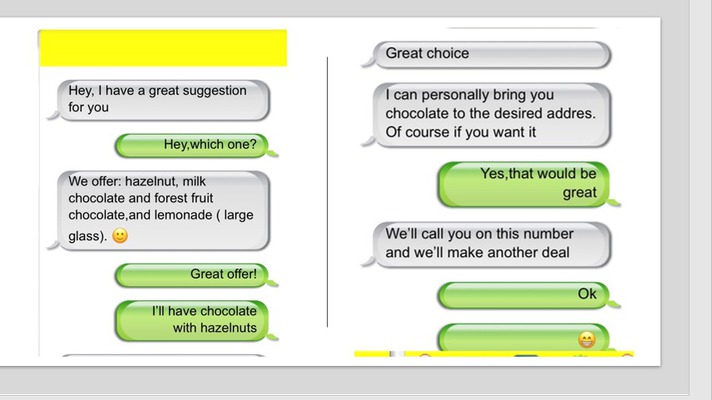

The second activity was to reflect on the language of commercial industry. We used Chat in MS Teams to share the ideas. The conclusions are:
1. The language of advertisements is always exaggerated and overwhelming.
2. Because of that it attracts everyone's attention.
3. It is still used because it works, it attracts people's attention, it is a way of using language to try to shows the products' worth/characteristics.
SPAIN
Some of our pupils conversations using advertisement language:
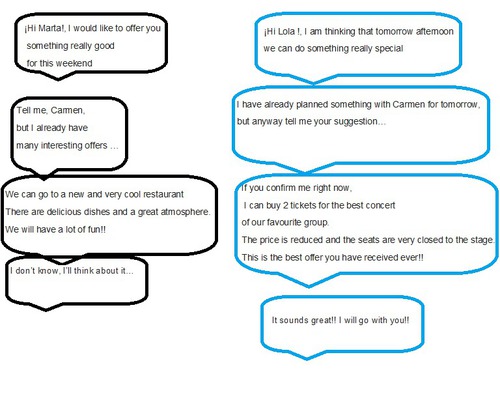
Conclusion of our reflectios:
- Is the language of the ads exaggerated?
Yes, it is very exaggerated, and even sometimes they try to convince us of ideas that are not true
- Do we pay more attention to ads for using this kind of language?
We pay more attention to ads because they use this exaggerated language
- If everyone knows that this language is exaggerated, why is it still used?
Because it works and makes us buy the products
SPEAKING SLOGANS WORKSHOP IN ITALY
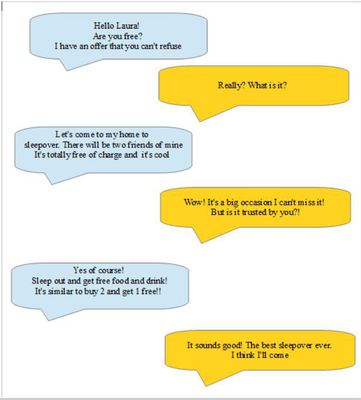
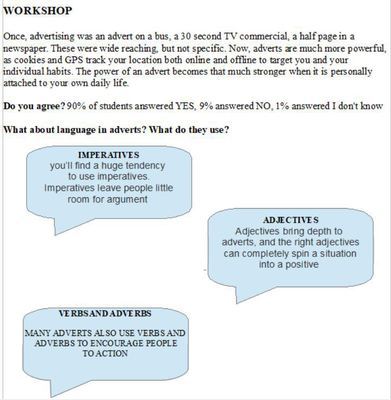
IS THE LANGUAGE EXAGGERATED? 100% OF STUDENTS ANSWERED YES
IF THE LANGUAGE IS EXAGGERATED, WILL WE PAY MORE ATTENTION?
YES, BECAUSE IN OUR SOCIETY EVERYTHING IS EXAGGERATED, ON TV WE ONLY SEE PEOPLE SHOUTING AND USING A BAD LANGUAGE. BUT WE DON'T LIKE IT, WE MUST RESPECT EVERYBODY AND EVERYONE'S IDEAS.
YES, BECAUSE IF IT ISN'T EXAGGERATED NOBODY WILL PAY ATTENTION ON IT AND BUY THE PRODUCTS.
YES, BECAUSE IF IT IS EXAGERRATED YOU WILL REMEMBER THE ADVERT AND YOU WILL BUY THE PRODUCT.
YES, BUT IT ISN'T GOOD I LIKE ADS THAT HAVEN'T GOT AN EXAGERRATED LANGUAGE I PREFER ADVERTS WITH A GOOD MESSAGE.
